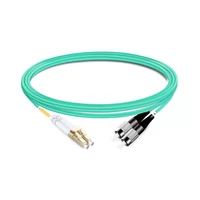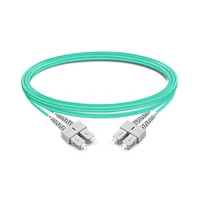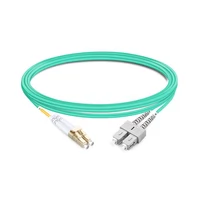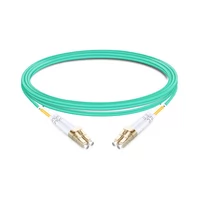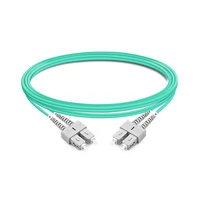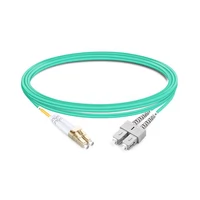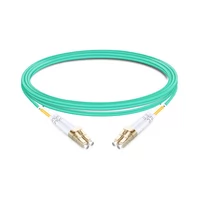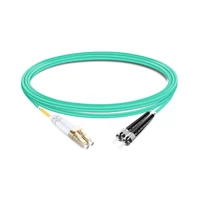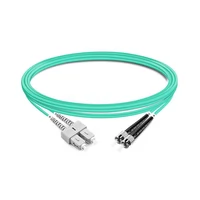In the swiftly moving world of fiber optic technology, OM3 multimode fiber is essential for high-speed data transmission. This expert manual proposes to give a complete understanding of OM3 multimode fiber, looking at its technical specifications, advantages, and practical applications vs. om2 vs. om3 vs. om4 fibers. We will cover core properties, performance metrics, and deployment scenarios, thereby providing you with all-around information about why this type of cabling is necessary in current networking infrastructures. Whether you are an industry professional or just someone passionate about tech stuff like me, reading this manual will widen your eyes on everything concerning OM3 multi-mode fiber in different hi-capacity communication environments.
Table of Contents
ToggleWhat is OM3?

Definition of Multimode
Multimode fiber refers to a kind of optical fiber that is able to transmit many light modes at the same time, hence allowing multiple signals to be carried in the same fiber. This is made possible by using a bigger core diameter, often 50 micrometers, which allows data transmission over short-to-medium distances at high speeds. Multimode fibers like OM3 are designed for high-bandwidth networks that can support speeds of up to 10 gigabits per second (Gbps) or more over distances of up to 300 meters. The most important advantage of multimode fiber is its low cost and easy installation; thus, it has become widely used in local area networks (LANs), data centers, and inter-building connections.
Key Characteristics of OM3
There are many things about it that make OM3 multimode fiber-optic cable the best choice for high-capacity, high-performance network infrastructures:
- The core diameter: 50μm which allows for support of multiple light modes and enables fast data transfer.
- Bandwidth: With a bandwidth capacity of up to 2000 MHz·km, fiber patch cables in different configurations can send information at rates greater than or equal to 10 Gbps over distances as far as 300 meters.
- Laser-optimized: These fibers work optimally when coupled with VCSELs operating at a wavelength of around 850 nm; thus, they deliver higher speed and reliability than other standards like om2 vs. om3 vs. om4.
- Proven applications: This type is widely used in data centers (DCs), local area networks (LAN) and storage area networks (SAN). It is reliable and supports scalable network requirements vs om1 fiber.
- Compatibility: It can be integrated into existing systems because it is backward compatible with previous multimode fiber optic cables such as OM1 or OM2, among others.
Therefore, these features make this kind of cable ideal for modern communication systems characterized by high speed and reliability.
Comparison of OM3 with Other Fibers
When compared to other types of cable, OM3 multimode fiber offers clear differences in performance, cost, and applications.
- OM1: OM1 fiber has a core diameter of 62.5 micrometers and can support bandwidths up to 200 MHz·km. It can work with lower data rates (1 Gbps) and shorter distances (300 meters with LED sources), which does not suit modern high-speed networks.
- OM2: The core diameter of OM2 fiber is also 50 micrometers as in OM3 but this type has a lower bandwidth capacity of 500 MHz·km and supports data rates of up to 1 Gbps over similar distances. Though it performs better than OM1, it still cannot be used for high-speed applications over long distances.
- OM4: The core diameter is also 50 micrometers, but the bandwidth capacity increases to 4700 MHz·km for OM4 fiber. This type enables data rates of up to 40 Gbps over 150 meters or even 100 Gbps over lesser distances, making it the best choice among ultra-high-speed networks available compared with OM3.
- Single-Mode Fiber (SMF): Single-mode fibers have much smaller core diameters (about 9 micrometers) than multimode ones; hence, they can transmit signals without significant attenuation over greater lengths (up to several kilometers). SMF is commonly used in long-haul and high-capacity networks, although its installation requires more effort and higher costs than multimode fibers.
To sum up, OM3 multimode fiber provides good performance at an affordable price, making it suitable for most intra-building networks and data centers. Nevertheless, if ultra-high speeds or longer links are needed, OM4 or single-mode fibers should be considered instead.
How Does OM3 Differ from OM1 and OM2?

OM1 vs OM2 vs OM3: Key Differences
Core Diameter: The core of OM1 fiber is 62.5 micrometers, while for both OM2 and OM3 fibers it is 50 micrometers.
Bandwidth Capacity: With a bandwidth capacity of only 200 MHz·km, OM1 does not work well with modern high-speed applications. Though better at 500 MHz·km, this still doesn’t match up to what can be achieved by using OM2, which gives you a whopping 2000MHz km, making it appropriate for higher data transmission speeds.
Data Rates and Distances: For LED sources, OM1 supports data rates up to 1 Gbps over distances of about 300 meters. The same rates apply for both types but over similar distances. Nevertheless, while the former can only handle up to 10Gbps within 300m or 40Gbps within shorter distances, its latter counterpart offers much superior performance required by today’s networks.
Applications: Normally designed for old systems, OM1 does not work well with new high-speed networks. Unlike the first two options, which can be used in many scenarios, OM1 is not good enough for ultra-high-speed applications, hence falling short on such grounds.OH3, being balanced between short-distance high-speed data centers and an Intra-building network, is recommended for this case.
OM3 vs OM2: Performance Comparison
There are several important differences in performance when you compare OM3 and OM2 fibers. For example, while OM2 fiber has a bandwidth capacity of 500 MHz·km, OM3 is designed for use in applications that require higher bandwidths, with its capacity being 2000 MHz·km. This means that data rates can be much larger on this type of fiber-optic cable, up to 10 Gbps over a distance up to 300 meters and even as fast as 40 Gbps for shorter distances – which makes it perfect for high-speed network demands in contemporary data centers.
Another key difference lies within modal dispersion: these two types possess different graded-index profiles—ones used in the latter case allow better signal integrity over longer spans than those found in the former. Such lower attenuation combined with a wider frequency range makes the third kind a more future-proofed option when selecting scalable network infrastructures that demand quicker data transmission rates and higher reliability levels.
Finally, considering application areas, while some older systems still can take advantage of using second-type cables for lower-speed LANs (Local Area Networks), they may not be suitable anymore due to their insufficiency in meeting current needs such as 10G Ethernet or other higher speed connections necessary within future-ready networks where third-type will work best.
OM1 and OM2: Compatibility with Modern Networks
The OM1 and OM2 fibers have helped create early network infrastructures; however, modern networks are incompatible. Usually having a 62.5-micrometer core, the OM1 fiber lacks support for the broader bandwidths required by fast networks today. These kinds of wires work in outdated systems only and cannot be used in contemporary environments where there is need for more data throughput with lower latency as compared to what can be achieved using OM3, OM4 or even OM5 technology.
OM2 fiber has a slightly better but still inadequate capability due to its 50-micrometer core — it also struggles to cope with current high-speed data demands. This wire does not support a distance of 10 Gbps Ethernet over long distances as it only has bandwidth capacity that goes up to 500 MHz·km hence making it suitable for use in short-haul applications or local area networks (LANs) where speeds are low. Unfortunately, though, even these qualifications do not make it ideal for meeting the needs of rapidly expanding computing environments, which require faster speeds across wide areas along with scalability at very high levels.
All in all, neither type meets modern standards set forth by increasingly faster broadband connections demanded from multi-mode optical cables such as those based on OM3 onwards, which offer increased speed over greater distances than previously required by any other kind of cable used within a data center.
What are the Benefits of Using OM3 Optic Cables?

High Bandwidth Capabilities of OM3
Comparable to om1 fibers, om3 optical fibers were made for greater bandwidth capacities in modern high-speed networks. An OM3 fiber cable has a 50 micrometer core optimized for higher bandwidth performance than both the OM1 and OM2 cables; it can achieve a bandwidth capacity of 2000 MHz·km. This means that they can support 10 Gigabit Ethernet over 300 meters or 40/100 Gigabit Ethernet up to 100 meters which makes them best suited for data centers where fast information transfer is required over long distances. In addition, these fibers also work with old network systems hence providing a smooth upgrade path to faster speeds without requiring too much change in infrastructure.
Cost-Effectiveness of OM3 Optic Cables
OM3 optical fibers are a cheap way to satisfy the need for fast data transmission. They can carry more bandwidth over greater distances, which reduces the requirement for more infrastructure and, therefore, cuts costs related to installing and keeping up that additional infrastructure. OM3 cables are usually cheaper than single-mode fibers as well as being easier to install so they provide a good compromise between performance and budget considerations. Moreover, these cables are backward and compatible with old network systems, which means that upgrades can be made gradually so as not only to prolong the life of existing infrastructure but also to minimize further expenditure on this account. In view of their durability plus low attenuation rates, OM3 optic cables offer an affordable yet high-performance solution suitable for contemporary data centers and enterprise networks, too.
Ease of Installation and Compatibility
An optic fiber called OM3 is designed to be very easy when it comes to installation which makes it suitable for different infrastructure requirements. They are larger in size than single mode fibers and therefore have more forgiving alignment tolerances that make the process of installation easier. This means that users can deploy quickly as they do not take much time or money.
Additionally, this type of cable is highly versatile and has many existing network components. These cables follow industry standards and are compatible with older models like OM1 and OM2, thereby integrating easily into already-set-up systems without the need for extensive modifications. It allows for upgrading networks in stages so that service delivery remains uninterrupted while at the same time increasing capacity for future bandwidth needs.
To conclude, because they can be easily installed and work well with other devices OM3 optical fibers are perfect for contemporary network environments such as data centers and enterprise networks where reliability and scalability are key factors.
Types of Available in the Market

OM3 vs OM4: What’s the Difference?
Comparing between OM3 and OM4 optical fibers, there are a number of technical differences that indicate their use in different applications.
Bandwidth and Distance Capabilities:
OM4 provides a higher bandwidth than OM3. While OM3 has a bandwidth of 2000 MHz·km, OM4 has a bandwidth of 4700 MHz·km. This increased bandwidth enables the support for longer distances in case the same data rates are used. To illustrate this, at a 10Gbps data rate, OM3 supports distances up to 300 meters, while OM4 can extend this to 550 meters.
Core Size:
Both cores are the same size, 50 micrometers, thereby allowing backward compatibility with existing installations like those made using OM2 or even older versions such as OM1.
Cost Considerations:
They offer better performance over greater distances due to wider bandwidths at higher frequencies, among other factors, making them more costly than their counterparts (OM3). In most cases, however, it comes down to what one needs vis-a-vis cost, so you balance these two aspects against each other depending on specific network requirements.
Application Areas for different multimode fiber types:
Given these optical capabilities, typically use environments where high capacity connectivity is required over long spans may include but are not limited to large-scale data centers connecting multiple server racks together or even enterprise networks seeking future-proofing against anticipated growth in bandwidth demand, etc.. On the other hand, if we talk about robustness, then yes, both types are strong performers; however, it should be noted that while being equally ruggedness, it still falls short when compared with om4, which gives us an indication about its affordability factor because not everyone will want extreme speed performance irrelevant distances but rather something just good enough.
The key characteristic differences between multimode fiber optic cables—such as om3 vs om4—can be seen in terms like speed (bandwidth), distance range covered by each type, and cost considerations that determine where they should be used.
OM3 vs OM4 vs OM5: Future-Proofing Your Network
When it comes to making a network future-proof, the decision between optical fibres OM3, OM4 and OM5 is determined by a number of performance criteria such as bandwidth, distance, cost and upgradeability.
Bandwidth and Distance Capabilities:
In comparison with OM3 or OM4 cables that only operate at one wavelength, the new standard (OM5) can run multiple signals using different wavelengths simultaneously over the same fiber. This multiplexing method boosts capacity to four times higher than that of any other type (OM4 vs om3 vs om5). While 4700 MHz·km for OM4 and 2000 MHz·km for OM3 might seem impressive figures too, they are nothing compared to what SWDM-enabled systems achieve – so if you’re planning on expanding your infrastructure in the future, then go with this option because it’s best suited for DCs’ LTIEs’.
Cost Considerations:
The rule of thumb while selecting fiber should always be based on cost. The upgraded designs are more expensive than their predecessors due largely in part because they offer more capabilities; however, those additional features come at a price. Still, there is no need to worry about it since these technologies will not require major changes within your system during upgrading, hence saving money that could have been used otherwise.
Areas of Applications:
On this point, we can say that all three types work well with current requirements, but beyond certain limits, each outperforms others, thus becoming ideal candidates under specific circumstances where the need for speed arises. For instance, when a 100Gbps connection becomes necessary, then nothing beats an environment supported by multimode fibers like those found in between racks at data centers, which are connected either directly to adjacent floors or even buildings apart from each other.
Conclusion:
If you want to keep up with the future, then go for OM5 rather than getting stuck into either OM3 or simply going halfway through an upgraded version of the two because this cable offers both high bandwidth and compatibility with emerging technologies that will require increased reach. Despite costing more at first glance, it is cheaper in the long run since there won’t be a need to change it later when you want to upgrade your network, so just think about how much money can be saved over time by investing now in future-proofing your infrastructure using this particular type of fiber optic cable.
Newest Type of What You Need to Know
The newest form of optical fiber that is becoming popular in the industry is called OM5 fiber, or wideband multimode fiber (WBMMF). It was created for short-wavelength division multiplexing (SWDM), where it allows multiple signals to be transmitted over one fiber by using different wavelengths, thereby greatly improving capacity and efficiency. This new kind of cable permits a more flexible and higher-capacity infrastructure, which makes it perfect for data centers and enterprise networks that need scalability over the long term.
OM5 fibers have large bandwidths – from 850 nm up to 950 nm – which is what sets them apart from other types, such as OM3 or OM4 fibers. These cables work mostly within the 850 nm wavelength range but this extended window supports faster data rates and future-proofs networks against emerging technologies with higher demands for capacity. Apart from this, their compatibility with older versions like OM3 or OM4 also ensures easy upgrades without requiring massive changes in infrastructure.
With regards to cost-effectiveness, initial investments into OM5 fibers are higher than those made into any previous generation counterparts. Nevertheless, considering advanced features as well as predicted savings on subsequent modifications, it might still be considered a strategic and economical choice eventually. The inability of this medium to cater to growing amounts of data without frequent alterations in structures leads to reduced operational expenditure over time.
Compared to OM1 fiber, which has been around forever but doesn’t offer much in terms of bandwidth or data rates, OM5 is the latest breed, boasting unrivaled bandwidth capabilities coupled with high data rates, making it ready for future needs, too. For businesses looking forward to scaling up their operations while keeping pace with changing technological requirements, there couldn’t be a better choice than this!
How do you select the right one for your needs?

Considerations for Network Requirements
While selecting the fiber that is most appropriate for your network, you must evaluate a number of factors that will enable it to perform optimally and also be scalable in the future.
- Bandwidth Requirements: You should know how much data your network currently needs to transmit as well as what it would require for future use. This means that OM5 fibers are able to allow for faster transmission rates due to their wide range of bandwidths between 850nm and 950nm thus making them ideal for networks where huge increase in volumes is anticipated.
- Distance: How long will this network operate? Compared to OM3 or OM4, transmissions can be done using OM5 fibers over greater distances, thereby reducing the number of repeaters required and potentially lowering overall costs.
- Compatibility: Confirm whether they are compatible with the current infrastructure. This implies that upgrading from an old version like OM3 or even OM4 could happen seamlessly without any hitches because backward compatibility has been enabled on newer models such as OM5 fiber optics, thus safeguarding investments made in past years.
- Cost Considerations: Consider both immediate expenditures and those incurred over time. While it may seem expensive initially, using OM5 cables can save you much more money in the long run since they have higher capacities, which support future technologies, hence minimizing the frequency of upgrades needed.
- Scalability: How big do you think your organization’s needs might grow? For example, if there are plans to expand operations significantly, advanced features found in these types of optical wires would ensure that no matter what stage current technology advances through, there will always be enough room ready for next-level advancements.
In conclusion, consider all these points carefully to choose a fiber optic solution that not only meets present requirements but also enhances performance while remaining cost-effective.
Understanding and Signal Quality
In fiber optic communication, signal quality is vital as it guarantees the correctness of data and best performance. Signal degradation emanates from many factors, which include attenuation, dispersion, and interference. Attenuation describes the diminishing of signal strength as it moves along the fiber; this may be lessened by using good-quality fibers like OM5. Pulse broadening and bandwidth limitation can be caused by dispersion – both chromatic and modal; some of these effects can be counteracted through employment-wide bandwidth in OM5 fibers. While external electromagnetic interference is not as much a concern in fiber optics as it is in copper cables, it still needs to be taken care of within complex environments. Therefore, for good signal quality, regular tests should be conducted, and advanced materials/technologies should be used.
Choosing the Right Connectors
The appropriate connectors for your fiber optic network must be carefully selected to ensure the best performance and reliability. Here are some of the most important things to consider:
- Types of Connector: LC, SC, ST, and MTP/MPO are some common connector types. LC connectors are small but highly efficient, suitable for use in high-density networks. SC connectors, on the other hand, have a push-pull mechanism that makes them easy to install or remove, while ST has a twist-lock design that is preferred in industrial settings. MTP/MPO can hold more than one fiber within a single connector, which is good for environments with high-speed data transmission.
- Insertion Loss and Return Loss: It is crucial to understand how much signal will be lost when it passes through different connectors – this is called insertion loss. Reflectivity back towards the source of light also needs to be measured – return loss. Those with low insertion losses and high return losses are better since they do not cause much degradation or interference of signals.
- Durability & Reliability: Connectors should be able to withstand various environmental conditions without breaking down easily, so durability matters most here, too. Opt for those robust enough to handle mechanical stresses, temperature changes, and humidity fluctuations.
These considerations can help you select suitable connectors that will support your network’s specific requirements, thus improving its performance and lifespan in general fiber optic systems.
Reference Sources
Frequently Asked Questions (FAQs)
Q: What is an OM3 multimode fiber?
A: An OM3 multimode fiber is a specially designed optical fiber for high-speed data transmission. It is created with 850nm VCSELs (Vertical-Cavity Surface-Emitting Lasers) in mind, and it supports 10Gbps Ethernet up to 300 meters; this makes it perfect for use in data centers and high-performance computing networks.
Q: How does OM3 fiber compare to OM2 and OM4 fibers?
A: This can be answered by comparing their bandwidth capacities and transmission distances. What differentiates om2 from om3 from om4 is the capacity of each type. For instance, while an OM3 fiber supports 10Gbps Ethernet over a distance of up to 300m and also provides for 40/100GbE at 100m reach, the shorter distance supported by an om2 fiber amounts to just 82m when transmitting data at rates of up to 10Gbps. On the other hand, when it comes to long-range applications such as those found within campuses or metropolitan areas where larger buildings need connecting.
Q: What are some typical uses for OM3 multimode fiber?
A: They are commonly employed in enterprise networks, data centers, and similar environments requiring high-performance computing capabilities. This includes, but is not limited to, their use alongside various types of multimode fibers within short-haul interconnections or intra-building cable runs, which support rates up through at least gigabit ethernet speed levels like ten base sr sfp+ transceivers, etcetera.
Q: Can I use OM3 with an OM4 network?
A: Yes! You can use your existing Gigabit Ethernet architecture built on OM3 optical fiber cable plants when upgrading to 40G or 100G connectivity by simply swapping out patch cords and transceivers with new models designed for higher speeds. OM4 fiber is fully backward compatible with OM3 fiber – all you need to do is make sure that both ends of a link are using the same type of multimode fiber – either OM2 or OM3 or OM4, etc. However, keep in mind that mixing different grades within a single channel can cause mode field diameter mismatch loss, limiting performance based on the specifications of whichever grade was used where it was worst.
Q: What are some differences between single-mode and multimode fibers?
A: Singlemode fibers have small cores capable of transmitting light signals over much greater distances than multimode fibers, but at higher bandwidths, too (hence why they’re used for long haul telecomms). On the other hand, Multimode fibers accommodate larger core sizes so they can accept multiple paths simultaneously, making them ideal for short-distance transmissions such as those encountered inside buildings where there might be many connections going from one room to another. To connect these two types, different optical fiber patch cables along with connectors are required.
Q: What does using multimode optical fiber offer?
A: Multimode optical fiber, such as OM3 and OM4, is a cost-effective solution for transmitting data over short to medium distances. It provides higher bandwidth and faster transmission rates across moderately faraway distances. Also, it allows the use of VCSELs, which drastically cuts down on installation charges compared with single-mode fibers.
Q: Why should I be concerned about transmission distance when choosing multimode fiber?
A: Transmission distance refers to the maximum length a signal can travel before suffering significant attenuation or requiring regeneration. Different types of multimode fibers (e.g., OM2, OM3, OM4, OM5) have different maximum distance limits. Matching your distance needed with the appropriate type of fiber will ensure the best performance while minimizing potential data loss in the link.
Q: What are fiber patch cables and patch cords?
A: Fiber patch cables or patch cords serve as a connection between various devices within a network. They comprise a fiber optic cable terminated with connectors on each end used for fast data transfer between equipment in data centers, telecom networks, enterprise networks, etc. For example; An OM3 Fiber Patch Cable (10Gbps/40Gbps/100Gbps Ethernet).
Q: Do people still use OM1 & OM2 multimode fibers?
A: Yes, although these fibers are older technologies with shorter transmission distances and lower bandwidth than Om3 vs. Om4 comparisons, they are still used in some legacy systems/applications where they remain suitable; however, most modern networks would favor using Om3 vs. Om4 fibers because their performance capabilities are much higher than those of Om1 vs. Om2 Fibers.
Related Products:
-
 1m (3ft) Duplex OM3 Multimode LC UPC to FC UPC PVC (OFNR) Fiber Optic Cable
$2.80
1m (3ft) Duplex OM3 Multimode LC UPC to FC UPC PVC (OFNR) Fiber Optic Cable
$2.80
-
 1m (3ft) Duplex OM3 Multimode SC UPC to SC UPC OFNP Fiber Optic Cable
$3.00
1m (3ft) Duplex OM3 Multimode SC UPC to SC UPC OFNP Fiber Optic Cable
$3.00
-
 1m (3ft) Duplex OM3 Multimode LC UPC to SC UPC OFNP Fiber Optic Cable
$3.00
1m (3ft) Duplex OM3 Multimode LC UPC to SC UPC OFNP Fiber Optic Cable
$3.00
-
 1m (3ft) Duplex OM3 Multimode LC UPC to LC UPC OFNP Fiber Optic Cable
$3.00
1m (3ft) Duplex OM3 Multimode LC UPC to LC UPC OFNP Fiber Optic Cable
$3.00
-
 1m (3ft) Duplex OM3 Multimode SC UPC to SC UPC LSZH Fiber Optic Cable
$3.00
1m (3ft) Duplex OM3 Multimode SC UPC to SC UPC LSZH Fiber Optic Cable
$3.00
-
 1m (3ft) Duplex OM3 Multimode LC UPC to SC UPC LSZH Fiber Optic Cable
$3.00
1m (3ft) Duplex OM3 Multimode LC UPC to SC UPC LSZH Fiber Optic Cable
$3.00
-
 1m (3ft) Duplex OM3 Multimode LC UPC to LC UPC LSZH Fiber Optic Cable
$3.00
1m (3ft) Duplex OM3 Multimode LC UPC to LC UPC LSZH Fiber Optic Cable
$3.00
-
 1m (3ft) Duplex OM3 Multimode SC UPC to SC UPC PVC (OFNR) Fiber Optic Cable
$3.00
1m (3ft) Duplex OM3 Multimode SC UPC to SC UPC PVC (OFNR) Fiber Optic Cable
$3.00
-
 1m (3ft) Duplex OM3 Multimode LC UPC to ST UPC PVC (OFNR) Fiber Optic Cable
$3.00
1m (3ft) Duplex OM3 Multimode LC UPC to ST UPC PVC (OFNR) Fiber Optic Cable
$3.00
-
 1m (3ft) Duplex OM3 Multimode LC UPC to SC UPC PVC (OFNR) Fiber Optic Cable
$3.00
1m (3ft) Duplex OM3 Multimode LC UPC to SC UPC PVC (OFNR) Fiber Optic Cable
$3.00
-
 1m (3ft) Duplex OM3 Multimode LC UPC to LC UPC PVC (OFNR) Fiber Optic Cable
$3.00
1m (3ft) Duplex OM3 Multimode LC UPC to LC UPC PVC (OFNR) Fiber Optic Cable
$3.00
-
 1m (3ft) Duplex OM3 Multimode SC UPC to ST UPC PVC (OFNR) Fiber Optic Cable
$5.20
1m (3ft) Duplex OM3 Multimode SC UPC to ST UPC PVC (OFNR) Fiber Optic Cable
$5.20

